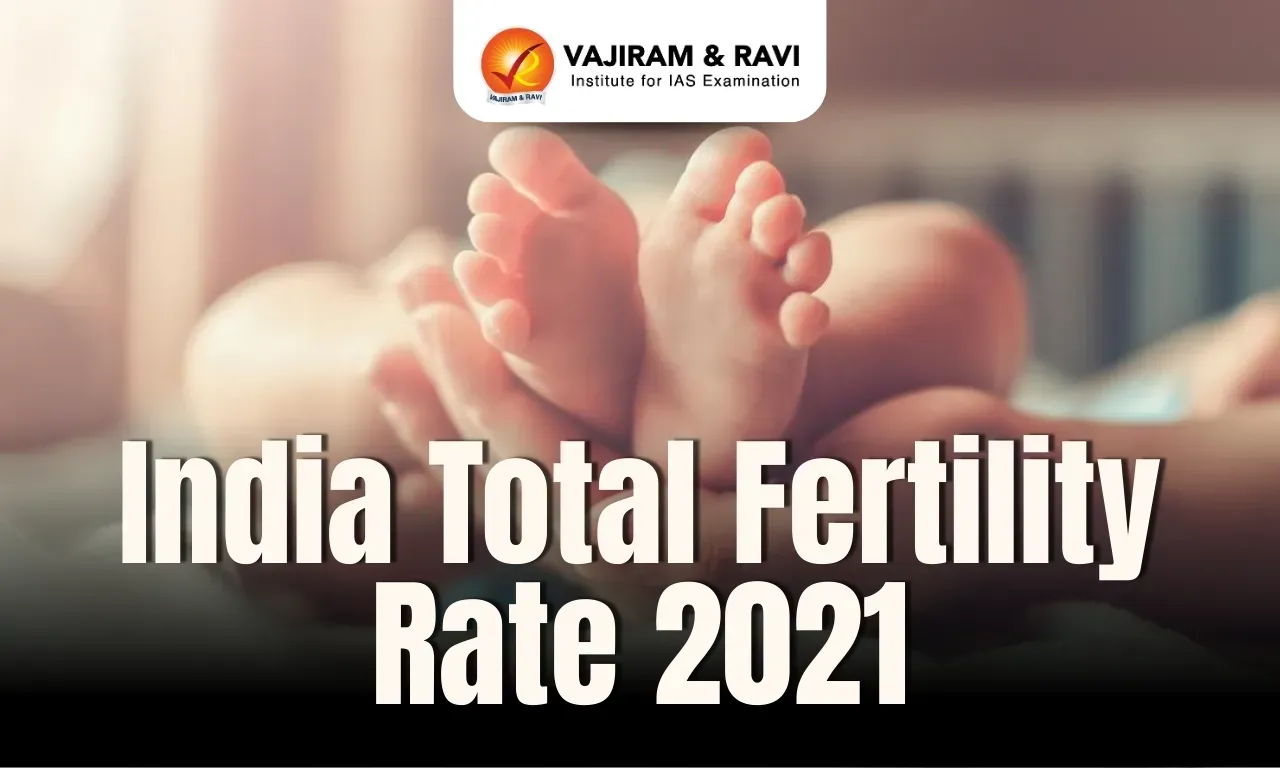What’s in Today’s Article?
- India’s Total Fertility Rate Latest News
- Introduction
- Total Fertility Rate Trends in 2021
- Demographic Shifts: Age Distribution and Elderly Population
- Changing Marriage Patterns and Their Impact
- Policy Responses and the Need for Updated Data
- Future Outlook: Opportunities and Challenges
- India’s TFR FAQs
India’s Total Fertility Rate Latest News
- According to the Sample Registration System (SRS) report for 2021 released by the Registrar General of India (RGI) on May 7, the Total Fertility Rate (TFR) in the country has remained constant at 2.0 in 2021.
Introduction
- India’s demographic profile is undergoing significant changes, as highlighted in the latest Sample Registration System (SRS) report for 2021, released by the Registrar General of India (RGI).
- The report confirms that the Total Fertility Rate (TFR) remains constant at 2.0, the same as in 2020.
- This reflects a continued trend towards population stabilization, with critical implications for social, economic, and healthcare policies.
Total Fertility Rate Trends in 2021
- The Total Fertility Rate (TFR) represents the average number of children a woman is expected to bear during her reproductive years.
- The replacement level TFR, required to sustain a stable population, is 2.1. India reaching a TFR of 2.0 suggests that it is on the path toward population stabilization, a major demographic milestone.
- Key State-Level Trends:
- Bihar reported the highest TFR at 3.0, indicating continuing high fertility trends in the state.
- Delhi and West Bengal recorded the lowest TFR at 1.4, well below replacement level.
- Other states achieving or falling below replacement level include Tamil Nadu (1.5), Andhra Pradesh (1.5), Kerala (1.5), Maharashtra (1.5), and Punjab (1.5).
- Gujarat and Haryana reported a TFR of 2.0, while Assam stood at 2.1, exactly at replacement level.
Demographic Shifts: Age Distribution and Elderly Population
- India’s age structure has experienced significant shifts over the past five decades. The proportion of the population aged 0-14 years has declined from 41.2% in 1971 to 24.8% in 2021.
- In contrast, the working-age population (15-59 years) has risen from 53.4% to 66.2%, positioning India advantageously for a demographic dividend.
- Growth in Elderly Population:
- The share of people aged 60 and above has increased from 6% in 1971 to 9% in 2021.
- Kerala has the highest elderly population at 14.4%, followed by Tamil Nadu (12.9%) and Himachal Pradesh (12.3%).
- States with the lowest elderly population include Bihar (6.9%), Assam (7.0%), and Delhi (7.1%).
Changing Marriage Patterns and Their Impact
- One of the critical factors influencing fertility rates is the rising age at marriage.
- The mean age at effective marriage for females has increased from 19.3 years in 1990 to 22.5 years in 2021.
- This trend reflects improved female education levels, increased workforce participation, and greater awareness of reproductive health, directly contributing to lower fertility rates.
Policy Responses and the Need for Updated Data
- During the 2024 Interim Budget, Finance Minister Nirmala Sitharaman announced plans for a high-power committee to address challenges posed by fast population growth and demographic changes.
- However, despite such announcements, India’s Census, originally scheduled for 2021, remains delayed, limiting comprehensive demographic analysis.
- The SRS data highlights that India’s population growth is no longer as “fast” as perceived.
- In fact, many states have reached or gone below the replacement level fertility rate, indicating a natural slowing of population growth.
Future Outlook: Opportunities and Challenges
- While the stabilization of TFR is a positive indicator for controlling population growth, it also brings new challenges.
- The rising elderly population will increase demand for healthcare services, pensions, and social welfare schemes.
- Simultaneously, India must capitalize on its demographic dividend by creating employment opportunities and strengthening social infrastructure to accommodate a growing working-age population.
- India’s demographic transition presents a critical window to implement forward-looking policies in healthcare, education, employment, and social welfare to ensure balanced and inclusive growth.
India’s TFR FAQs
Q1. What is India’s Total Fertility Rate according to the latest report?
Ans. India’s Total Fertility Rate remained constant at 2.0 in 2021.
Q2. Which state recorded the highest fertility rate in 2021?
Ans. Bihar reported the highest fertility rate at 3.0.
Q3. Which states have the lowest Total Fertility Rate?
Ans. Delhi and West Bengal reported the lowest TFR at 1.4.
Q4. What is the current mean age at effective marriage for women in India?
Ans. The mean age at marriage for females has increased to 22.5 years in 2021.
Q5. Which state has the highest proportion of elderly population?
Ans. Kerala has the highest elderly population, with 14.4% of its residents aged 60 and above.
Source: TH
Last updated on June, 2025
→ UPSC Notification 2025 was released on 22nd January 2025.
→ UPSC Prelims Result 2025 is out now for the CSE held on 25 May 2025.
→ UPSC Prelims Question Paper 2025 and Unofficial Prelims Answer Key 2025 are available now.
→ UPSC Calendar 2026 is released on 15th May, 2025.
→ The UPSC Vacancy 2025 were released 1129, out of which 979 were for UPSC CSE and remaining 150 are for UPSC IFoS.
→ UPSC Mains 2025 will be conducted on 22nd August 2025.
→ UPSC Prelims 2026 will be conducted on 24th May, 2026 & UPSC Mains 2026 will be conducted on 21st August 2026.
→ The UPSC Selection Process is of 3 stages-Prelims, Mains and Interview.
→ UPSC Result 2024 is released with latest UPSC Marksheet 2024. Check Now!
→ UPSC Toppers List 2024 is released now. Shakti Dubey is UPSC AIR 1 2024 Topper.
→ Also check Best IAS Coaching in Delhi























